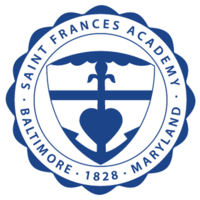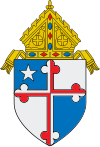St. Frances Academy (Baltimore, Maryland)
| Saint Frances Academy | |
|---|---|
 | |
| Address | |
 | |
501 East Chase Street , 21202 | |
| Coordinates | 39°18′8″N 76°36′30″W / 39.30222°N 76.60833°WCoordinates: 39°18′8″N 76°36′30″W / 39.30222°N 76.60833°W |
| Information | |
| Type | Private |
| Motto | Providentia Providebit (Providence will Provide) |
| Religious affiliation(s) | Roman Catholic (Oblate Sisters of Providence) |
| Denomination | Catholic |
| Established | 1828 |
| Founder | Mother Mary Lange, OSP |
| Oversight | Oblate Sisters of Providence |
| CEEB code | 210185 |
| Head of school | Deacon Curtis Turner, Ed.D. |
| Teaching staff | 14 |
| Grades | 9–12 |
| Gender | Coeducational |
| Enrollment | 210 |
| Average class size | 18 |
| Student to teacher ratio | 15:1 |
| Campus size | 2.96 Acres |
| Campus type | Urban |
| Color(s) | Blue & White Athletics: Black & Gold |
| Slogan | "We can. We will. We must." |
| Athletics | MIAA, IAAM |
| Mascot | Panthers |
| Nickname | SFA |
| Team name | Panthers |
| Rival | Everybody |
| Accreditation | Middle States Association of Colleges and Schools[1] |
| Yearbook | The Counsellor |
| School fees | $0 |
| Tuition | $11,300 |
| Affiliation | Catholic school |
| NCEA School ID | 1026047 |
| Website | www |
St. Frances Academy is an independent Catholic high school in Baltimore, Maryland. Founded in 1828, it is the first and oldest continually operating Black Catholic educational facility in the United States.
History[]
Background[]
In the early 1800s, various Protestant organizations in Baltimore such as Sharp Street Methodist Episcopal Church’s Free African School (1802), Daniel Coker’s Bethel Charity School (c. 1812), St. James Protestant Episcopal Day School (1824), and William Lively’s Union Seminary (1825) created schools for African-American students. While providing a valuable service, they could not meet the demands of Baltimore’s growing free African-American population. (There were no free public schools for children of color in Baltimore until 1866.) Mother Mary Lange recognized the need for education for African American children and opened a school for them in her home in the Fells Point area of the city.
Early years[]
On June 13, 1828, the Oblate School for Colored Girls opened for its first year at 5 St. Mary's Court in Baltimore's Seton Hill neighborhood, northwest of downtown, near St. Mary's Seminary and College, then located on North Paca Street, the first Catholic seminary in America, founded 1791.[2][3] It was established with the mission to teach "children of color to read the Bible" —which, since it included teaching slaves, was at the time illegal.[4]
The following year in 1829, the school taught out of 610 George Street and then 48 Richmond Street (now West Read Street), a few blocks away.[5] The school graduated its first class with ceremonies in 1832.
By 1853, the school changed its name from the Oblate School for Colored Girls to the Saint Frances School for Colored Girls, named after St. Frances of Rome (1384–1440), and later shortened and elevated to the Saint Frances Academy.[6]
In 1871, the school moved to its current location in inner East Baltimore at 501 East Chase Street in what is now the Johnston Square neighborhood.
Modern era[]
The high school began admitting boys in the 1970s.[7] The school now offers a traditional, co-educational, college-preparatory curriculum for students in grades nine through twelve.
An honors program is available to select students and all students complete a community service component. Independently owned and operated by the Oblates, the school is approved by the Maryland State Department of Education and is accredited by the Commission on Secondary Schools of the regional agency of the Middle States Association of Colleges and Schools.
The student population is still predominantly African-American.
Bill and Camille Cosby donations[]
In 2012, Camille Cosby, an alumna of a school in Washington run by the Oblates, and her husband Bill Cosby made a donation to assist St. Frances Academy in building a community center in East Baltimore.[8] The community center was originally named after her and her husband, but his name was removed after the revelation of multiple sexual offenses.[9]
Athletics[]
St. Frances' football program has become the subject of controversy within Maryland in the late 2010s. After former Gilman School coach took over as head coach, he began aggressively recruiting talented players from inside and outside Maryland, to a greater degree than other private schools in the state did. Within a few seasons St. Frances became effectively unbeatable by their traditional opponents in the Maryland Interscholastic Athletic Association (MIAA), regularly defeating them by wide margins.[10]
Before 2018 those teams told St. Frances they would no longer play them, citing safety concerns as many of St. Frances' recruits were well outside the typical height and weight range for high school players and more in line with college football teams. Some St. Frances supporters believe the opponents' real motives are racial since there had been no complaints when predominantly white teams like Gilman had been similarly successful in earlier seasons. The team won the MIAA championship before the season even started since all those opponents had to forfeit their games, but scheduled intrasquad scrimmages, opponents from as far away as Canada, and road trips to the South for the players' benefit.[10]
The Men's Basketball team has won the MIAA A Conference Championships in 2008–09, 2009–10, 2012–13, 2015–16, 2018–19.[11] The Women's Basketball team has won the IAAM A Conference Championships in 2000–01, 2001–02, 2002–03, 2003–04, 2004–05, 2005–06, 2006–07, 2007–08, 2009–10, 2015–16, 2016–17, 2017–18, 2018–19, 2019-20[12]
Notable alumni[]

- Jamal K. Atkins (c/o 1995), Coach & Trainer, Basketball Academy of Excellence (Zambia)
- Daquan Bracey (c/o 2016), professional basketball player for Saigon Heat of the ASEAN Basketball League in Vietnam
- Melba Chambers (c/o 1995), Assistant Coach, Women's Basketball, Georgetown
- Darnell Harris (c/o 2004), professional basketball player for Larisa of the Greek Basketball League
- Billie Holiday (Orphanage/Primary School, 1920), jazz singer and songwriter[13][14]
- Mark Karcher (c/o 1997), professional basketball player for Richmond Rhythm of the IBL
- Calvin Kenon (c/o 2005), composer/songwriter, credits include Ciara's "Like A Boy" and Jamie Foxx's "Intuition"
- Angel McCoughtry (c/o 2004), two time Olympian, basketball player for WNBA Atlanta Dream
- Dwayne Morgan (c/o 2014), professional basketball player for of the Nemzeti Bajnokság I/A
- Sean Mosley (c/o 2008), basketball player for Hapoel Tel Aviv B.C. of the Israeli Basketball Premier League
- Devin Phelps (c/o 2015), football player for Arizona Cardinals
- Sandra Williams Ortega, PhD (c/o 1953), Maryland’s First African American Woman Commissioned U.S. Air Force Officer
- Shadae Swan (c/o 2004), Head Coach, Women's Basketball, Bowie State University
- Devin Antoine Gray (c/o 1991), 1996 - 1997 National_Basketball_Association (NBA) Sacramento_Kings and San_Antonio_Spurs, 1997 - 1998 Spain's Primera_División_de_Baloncesto, 1999 - 2000 National_Basketball_Association Houston_Rockets
- Terrell Vinson (c/o 1995), professional basketball player for Grindavik in Iceland – Express League
- Corey Yow (c/o 2002), Producer for MSNBC's Morning Joe
See also[]
- Mother Mary Lange, Foundress of Saint Frances Academy
Notes and references[]
- ^ MSA-CSS. "MSA-Commission on Secondary Schools". Archived from the original on 2009-07-12. Retrieved 2009-07-31.
- ^ Banks, Willa Young. "A Contradiction in Antebellum Baltimore: A Competitive School for Girls of 'Color' within a Slave State". Maryland Historical Magazine. Vol. 99 no. 2. Maryland Historical Society. pp. 132–163.
- ^ Morrow, Diane (2002). Person of Color and Religious at the Same Time. University of North Carolina Press.
- ^ Moore, Ralph Jr.; Flowers, Willie (2020-02-08). "Mother Mary Lange's Sainthood: If Not Now When?". Afro. Retrieved 2021-07-10.
- ^ "The Oblate Sisters of Providence and Early African American" (PDF). Maryland Historical Society. Retrieved 2019-07-18.
- ^ "The Oblate School for Colored Girls: Historical Background" (PDF). Maryland Historical Society. Retrieved 2019-07-18.
- ^ SFA. "St. Frances Academy Historic Narrative". Retrieved 2007-05-08.
- ^ Hare, Mary Gail. "Baltimore school honors the Cosbys", Baltimore Sun, April 20, 2012
- ^ Green, Erica L., "Baltimore Catholic school to name community center after Bill and Camille Cosby", Baltimore Sun, March 30, 2012
- ^ a b Stanley, Tiffany (January 28, 2019). "The Lost Season". Washington Post Magazine. Retrieved February 7, 2019.
- ^ "MIAA A Conference Basketball Championships". Maryland Interscholastic Athletic Association. Retrieved 2019-07-18.
- ^ "IAAM A Conference Basketball Championships". Interscholastic Athletic Association of Maryland. Retrieved 2021-03-27.
- ^ "As Billie Holiday biopic celebrates Golden Globe win for lead actress, a look back at the jazz legend raised in Baltimore". Baltimore Sun. Retrieved 2021-03-09.
- ^ "Riding the black history trail, again". The Catholic Review. Retrieved 2021-03-09.
External links[]
- Catholic secondary schools in Maryland
- Private schools in Baltimore
- Educational institutions established in 1828
- 1828 establishments in Maryland
- African-American Roman Catholicism
- African-American Roman Catholic schools

